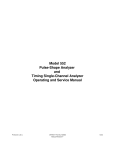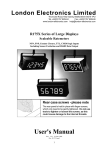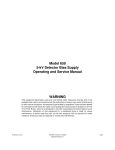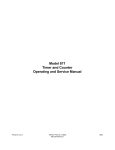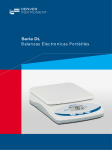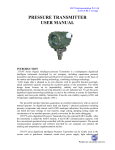Download ORTEC Model 583B User Manual 931002 Rev. C
Transcript
Model 583B
Constant Fraction Differential
Discriminator
Operating Manual
Printed in U.S.A.
ORTEC® Part No. 931002
Manual Revision D
1209
Advanced Measurement Technology, Inc.
a/k/a/ ORTEC®, a subsidiary of AMETEK®, Inc.
WARRANTY
ORTEC* warrants that the items will be delivered free from defects in material or workmanship. ORTEC makes no other
warranties, express or implied, and specifically NO WARRANTY OF MERCHANTABILITY OR FITNESS FOR A
PARTICULAR PURPOSE.
ORTEC’s exclusive liability is limited to repairing or replacing at ORTEC’s option, items found by ORTEC to be defective
in workmanship or materials within one year from the date of delivery. ORTEC’s liability on any claim of any kind,
including negligence, loss, or damages arising out of, connected with, or from the performance or breach thereof, or from
the manufacture, sale, delivery, resale, repair, or use of any item or services covered by this agreement or purchase
order, shall in no case exceed the price allocable to the item or service furnished or any part thereof that gives rise to
the claim. In the event ORTEC fails to manufacture or deliver items called for in this agreement or purchase order,
ORTEC’s exclusive liability and buyer’s exclusive remedy shall be release of the buyer from the obligation to pay the
purchase price. In no event shall ORTEC be liable for special or consequential damages.
Quality Control
Before being approved for shipment, each ORTEC instrument must pass a stringent set of quality control tests designed
to expose any flaws in materials or workmanship. Permanent records of these tests are maintained for use in warranty
repair and as a source of statistical information for design improvements.
Repair Service
If it becomes necessary to return this instrument for repair, it is essential that Customer Services be contacted in
advance of its return so that a Return Authorization Number can be assigned to the unit. Also, ORTEC must be informed,
either in writing, by telephone [(865) 482-4411] or by facsimile transmission [(865) 483-2133], of the nature of the fault
of the instrument being returned and of the model, serial, and revision ("Rev" on rear panel) numbers. Failure to do so
may cause unnecessary delays in getting the unit repaired. The ORTEC standard procedure requires that instruments
returned for repair pass the same quality control tests that are used for new-production instruments. Instruments that
are returned should be packed so that they will withstand normal transit handling and must be shipped PREPAID via
Air Parcel Post or United Parcel Service to the designated ORTEC repair center. The address label and the package
should include the Return Authorization Number assigned. Instruments being returned that are damaged in transit due
to inadequate packing will be repaired at the sender's expense, and it will be the sender's responsibility to make claim
with the shipper. Instruments not in warranty should follow the same procedure and ORTEC will provide a quotation.
Damage in Transit
Shipments should be examined immediately upon receipt for evidence of external or concealed damage. The carrier
making delivery should be notified immediately of any such damage, since the carrier is normally liable for damage in
shipment. Packing materials, waybills, and other such documentation should be preserved in order to establish claims.
After such notification to the carrier, please notify ORTEC of the circumstances so that assistance can be provided in
making damage claims and in providing replacement equipment, if necessary.
Copyright © 2009, Advanced Measurement Technology, Inc. All rights reserved.
*ORTEC® is a registered trademark of Advanced Measurement Technology, Inc. All other trademarks used herein are the
property of their respective owners.
iii
CONTENTS
WARRANTY . . . . . . . . . . . . . . . . . . . . . . . . . . . . . . . . . . . . . . . . . . . . . . . . . . . . . . . . . . . . . . . . . . . . . . . . . . . . . . . . . ii
SAFETY INSTRUCTIONS AND SYMBOLS . . . . . . . . . . . . . . . . . . . . . . . . . . . . . . . . . . . . . . . . . . . . . . . . . . . . . . . iv
SAFETY WARNINGS AND CLEANING INSTRUCTIONS . . . . . . . . . . . . . . . . . . . . . . . . . . . . . . . . . . . . . . . . . . . . . v
1. DESCRIPTION . . . . . . . . . . . . . . . . . . . . . . . . . . . . . . . . . . . . . . . . . . . . . . . . . . . . . . . . . . . . . . . . . . . . . . . . . . .
1.1. DISCRIMINATION AND SINGLE-CHANNEL ANALYSIS . . . . . . . . . . . . . . . . . . . . . . . . . . . . . . . . . . . . .
1.2. CONSTANT FRACTION PRINCIPLE . . . . . . . . . . . . . . . . . . . . . . . . . . . . . . . . . . . . . . . . . . . . . . . . . . . .
1.3. INPUT/OUTPUT CHARACTERISTICS . . . . . . . . . . . . . . . . . . . . . . . . . . . . . . . . . . . . . . . . . . . . . . . . . .
1
1
1
1
2. SPECIFICATIONS . . . . . . . . . . . . . . . . . . . . . . . . . . . . . . . . . . . . . . . . . . . . . . . . . . . . . . . . . . . . . . . . . . . . . . . .
2.1. PERFORMANCE . . . . . . . . . . . . . . . . . . . . . . . . . . . . . . . . . . . . . . . . . . . . . . . . . . . . . . . . . . . . . . . . . . .
2.2. CONTROLS . . . . . . . . . . . . . . . . . . . . . . . . . . . . . . . . . . . . . . . . . . . . . . . . . . . . . . . . . . . . . . . . . . . . . . .
2.3. INPUT . . . . . . . . . . . . . . . . . . . . . . . . . . . . . . . . . . . . . . . . . . . . . . . . . . . . . . . . . . . . . . . . . . . . . . . . . . . .
2.4. OUTPUTS . . . . . . . . . . . . . . . . . . . . . . . . . . . . . . . . . . . . . . . . . . . . . . . . . . . . . . . . . . . . . . . . . . . . . . . . .
2.5. ELECTRICAL AND MECHANICAL . . . . . . . . . . . . . . . . . . . . . . . . . . . . . . . . . . . . . . . . . . . . . . . . . . . . . .
2
2
2
3
3
3
3. INSTALLATION . . . . . . . . . . . . . . . . . . . . . . . . . . . . . . . . . . . . . . . . . . . . . . . . . . . . . . . . . . . . . . . . . . . . . . . . . . .
3.1. GENERAL . . . . . . . . . . . . . . . . . . . . . . . . . . . . . . . . . . . . . . . . . . . . . . . . . . . . . . . . . . . . . . . . . . . . . . . . .
3.2. POWER CONNECTION . . . . . . . . . . . . . . . . . . . . . . . . . . . . . . . . . . . . . . . . . . . . . . . . . . . . . . . . . . . . . .
3.3. INPUT CONNECTION . . . . . . . . . . . . . . . . . . . . . . . . . . . . . . . . . . . . . . . . . . . . . . . . . . . . . . . . . . . . . . .
3.4. OUTPUT CONNECTIONS . . . . . . . . . . . . . . . . . . . . . . . . . . . . . . . . . . . . . . . . . . . . . . . . . . . . . . . . . . . .
3.5. CF DELAY CABLE . . . . . . . . . . . . . . . . . . . . . . . . . . . . . . . . . . . . . . . . . . . . . . . . . . . . . . . . . . . . . . . . . .
3
3
3
3
3
4
4. OPERATION . . . . . . . . . . . . . . . . . . . . . . . . . . . . . . . . . . . . . . . . . . . . . . . . . . . . . . . . . . . . . . . . . . . . . . . . . . . . .
4.1. DIFFERENTIAL MODE . . . . . . . . . . . . . . . . . . . . . . . . . . . . . . . . . . . . . . . . . . . . . . . . . . . . . . . . . . . . . . .
4.2. INTEGRAL MODE . . . . . . . . . . . . . . . . . . . . . . . . . . . . . . . . . . . . . . . . . . . . . . . . . . . . . . . . . . . . . . . . . .
4.3. SLOW RISE-TIME REJECT MODE . . . . . . . . . . . . . . . . . . . . . . . . . . . . . . . . . . . . . . . . . . . . . . . . . . . . .
4
5
5
5
5. TYPICAL APPLICATIONS . . . . . . . . . . . . . . . . . . . . . . . . . . . . . . . . . . . . . . . . . . . . . . . . . . . . . . . . . . . . . . . . . .
5.1. GENERAL . . . . . . . . . . . . . . . . . . . . . . . . . . . . . . . . . . . . . . . . . . . . . . . . . . . . . . . . . . . . . . . . . . . . . . . . .
5.2. FAST SYSTEM . . . . . . . . . . . . . . . . . . . . . . . . . . . . . . . . . . . . . . . . . . . . . . . . . . . . . . . . . . . . . . . . . . . . .
5.3. FAST/SLOW SYSTEM . . . . . . . . . . . . . . . . . . . . . . . . . . . . . . . . . . . . . . . . . . . . . . . . . . . . . . . . . . . . . . .
6
6
6
6
6. REFERENCES . . . . . . . . . . . . . . . . . . . . . . . . . . . . . . . . . . . . . . . . . . . . . . . . . . . . . . . . . . . . . . . . . . . . . . . . . . . 7
iv
SAFETY INSTRUCTIONS AND SYMBOLS
This manual contains up to three levels of safety instructions that must be observed in order to avoid personal injury
and/or damage to equipment or other property. These are:
DANGER
Indicates a hazard that could result in death or serious bodily harm if the safety instruction is not
observed.
WARNING
Indicates a hazard that could result in bodily harm if the safety instruction is not observed.
CAUTION
Indicates a hazard that could result in property damage if the safety instruction is not observed.
Please read all safety instructions carefully and make sure you understand them fully before attempting to use this
product.
v
SAFETY WARNINGS AND CLEANING INSTRUCTIONS
DANGER
Opening the cover of this instrument is likely to expose dangerous voltages. Disconnect the
instrument from all voltage sources while it is being opened.
WARNING Using this instrument in a manner not specified by the manufacturer may impair the protection
provided by the instrument.
Cleaning Instructions
To clean the instrument exterior:
! Unplug the unit from the ac power supply.
! Remove loose dust on the outside of the instrument with a lint-free cloth.
! Remove remaining dirt with a lint-free cloth dampened in a general-purpose detergent and water solution. Do not
use abrasive cleaners.
CAUTION To prevent moisture inside of the instrument during external cleaning, use only enough liquid to
dampen the cloth or applicator.
!
Allow the instrument to dry completely before reconnecting it to the power source.
vi
1
ORTEC MODEL 583B
CONSTANT FRACTION DIFFERENTIAL DISCRIMINATOR
1. DESCRIPTION
The ORTEC Model 583B Constant Fraction Differential
Discriminator/Single-Channel Analyzer is a single-width
NIM module that generates accurate timing output
signals for a variety of applications. It accepts input
pulses in the range of 0 to !10 V and generates NIM
fast negative outputs and a slow positive output that are
based on the Constant Fraction time derivation. The
583B can be operated as an integral discriminator or as
a single-channel analyzer (SCA) for the anode signals
from fast photomultiplier tubes. It provides excellent
timing characteristics for a wide dynamic range of input
signal amplitudes.
The front-panel SRT setting gives you a slow rise-time
reject feature that inhibits the discriminator response to
input signals that would cause leading-edge timing.
The input impedance of the 583B is 50 Ω, and the NIM
fast logic output signals are designed for termination in
50 Ω. A NIM slow positive SCA output is also furnished
with an output impedance of <10 Ω.
In the Constant Fraction technique, an input signal to
the constant fraction (CF) circuitry is delayed, and a
fraction of the undelayed pulse is subtracted from it. A
bipolar signal is generated, and its zero crossing is
detected and used to produce an output logic pulse.The
CF shaping delay is controlled by the length of cable
externally connected between the two DELAY
connectors on the front panel. This shaping delay
should be optimized for each specific application.
Optimization requires prior knowledge of the rise-time
and nominal width of the input signals to the 583B.
Although input pulses can range from 0 to !10 V, the
discriminator levels range from !30 mV to !5 V. This
discriminator range is adequate for most applications.
1.1. DISCRIMINATION AND SINGLECHANNEL ANALYSIS
The 583B has a front-panel toggle switch that lets you
choose between integral (INT) and differential (DIFF)
discriminator. When the 583B is operated as an integral
discriminator (integral mode), each input pulse that
exceeds the adjusted lower-level threshold set on the
583B front panel causes a set of timing output signals
to be generated. To generate the timing output signals
in differential mode, the input signal must exceed the
lower-level threshold and must not exceed the upperlevel threshold for approximately 10 ns after the
Constant Fraction zero-crossing time. This is the
principle of fast single-channel analysis.
NOTE In differential mode, you must set the lowerlevel threshold to a lower value than the upperlevel threshold, or the 583B will not generate a
timing output signal.
Other features of the 583B include:
!
!
A slow rise-time reject function.
A variable width blocking one-shot.
The 583B also has a connector and width-adjustment
potentiometer for generating and controlling a blocking
one-shot pulse. This blocking one-shot is initiated
simultaneously with the timing output signals, and
prevents the unit from generating additional timing
output signals during the selected blocking period.
1.2. CONSTANT FRACTION PRINCIPLE
1.3. INPUT/OUTPUT CHARACTERISTICS
The 583B accepts negative input signals up to !10 V
without saturation. The primary usage of the 583B is
expected to be with the anode signals from
photomultiplier tubes. However, for integral-mode
applications, other sources of negative signals, such as
timing filter amplifiers, may also be used.
If an input signal satisfies the logic conditions
established with the 583B, four output pulses are
simultaneously initiated:
!
!
!
Two timing output signals from the front-panel
TIMING OUTPUTS connectors. These are separate,
negative NIM fast-logic pulses, nominally 5 ns in
width.
A slow positive NIM output through a rear-panel
BNC.
The blocking output from the front-panel BK OUT
connector. This is a negative current pulse similar to
a NIM fast-logic pulse, except that the width is
determined by the front-panel WIDTH control
2
potentiometer. The width of the blocking output is set
by the period of the internal blocking one-shot, which
can range from #15 ns to $1000 ns.
In addition, an upper level output pulse is generated
when the internal upper-level discriminator is triggered
by an input signal. This is a NIM standard fast-negative
logic pulse, and is generated in both differential and
integral modes.
2. SPECIFICATIONS
!
2.1. PERFORMANCE
INPUT PULSE Accepts negative input pulses from
0 to !10 V without saturation; input protected against
overload; reflections #10% for input risetime $2 ns.
DISCRIMINATOR RANGES
Upper Level !30 mV to !5 V
Lower Level !30 mV to !5 V
!
THRESHOLD INTEGRAL NONLINEARITY
of full scale.
THRESHOLD INSTABILITY
#±0.5%
#±0.1 mV/EC, 0–50EC.
TIME WALK #±75 ps for 100:1 dynamic range;
integral mode with external shaping delay ~2 ns, input
risetime #1 ns, input pulse width ~10 ns,
threshold = 30 mV.
Variable from #15 to $1000 ns.
MINIMUM PULSE-PAIR RESOLUTION ~50 ns for
input pulse width #10 ns, or pulse width at the arming
threshold +40 ns for input pulse width $10 ns.
2.2. CONTROLS
UPPER LEVEL Front-panel, 5-turn precision locking
potentiometer used to determine the upper-level (UL)
discriminator threshold setting.
LOWER LEVEL Front-panel, 5-turn precision locking
potentiometer used to determine the lower-level (LL)
discriminator threshold setting. Also automatically
adjusts the threshold level for the constant-fraction pickoff arming discriminator. Adjustable internally from 0.5
to 1.0 times the LL threshold (factory set to 0.5).
DISCRIMINATOR MODE Front-panel, 2-position
locking toggle switch selects one of two modes:
INT (integral) Functions as an integral discriminator. The LL threshold sets the minimum input
signal amplitude required to produce an output
pulse. The UL discriminator is not used to determine
the timing response from the instrument.
TIMING MODE Front-panel, 2-position locking toggle
switch selects one of two modes:
!
PROPAGATION DELAY Nominally 18 ns with external shaping delay ~2 ns.
BLOCKING WIDTH
DIFF (differential) Functions as an SCA. The LL
and UL thresholds are each independently
adjustable from !30 mV to !5 V. To produce an
output pulse, the input signal must cross the LL
threshold, but must not cross the UL threshold within
approximately 10 ns after the constant-fraction zerocrossing time.
!
CF (constant fraction) The instrument operates in
the constant-fraction timing mode. The constantfraction attenuation factor is internally set at 0.2. An
external 50-Ω cable must be provided for the
constant-fraction shaping delay.
SRT (slow-rise-time reject) Inhibits output signals
that would be produced by leading-edge timing from
the LL and UL discriminators. An input signal that
does not cross the LL threshold before the constantfraction zero-crossing time does not produce an
output pulse. In DIFF mode, an input signal that
does not cross the UL threshold before the constantfraction zero-crossing time will not be inhibited by the
UL discriminator from producing an output pulse.
DELAY A pair of front-panel BNC connectors that
accept 50-Ω coaxial cable to set the required constantfraction shaping delay; total delay is ~0.7 ns plus the
delay of the external cable.
WALK ADJUST Front-panel, 20-turn screwdriver
adjustment for setting the walk compensation for each
application.
WALK MONITOR Front-panel test point, adjacent to
the walk adjust potentiometer, permits monitoring the
actual dc voltage that is set for the zero-crossing
3
!0.5 mV to
further timing pulses from being generated during the
blocking period; variable from #15 to$1000 ns.
CF MONITOR Front-panel BNC connector that allows
observation of the constant-fraction bipolar timing
signal; 50-Ω cable and 50-Ω terminator required.
POSITIVE SCA Rear-panel BNC connector provides
a NIM-standard slow positive logic signal. Occurs
simultaneously with timing outputs.
WIDTH ADJUST Front-panel, 20-turn screwdriver
adjustment for setting the width of the pulse at the
blocking output; variable from #15 to$1000 ns.
UPPER LEVEL (UL) Rear-panel BNC connector
provides a NIM-standard fast negative logic signal.
Occurs as the leading edge of the input signal crosses
the UL threshold.
reference; normally set in the range of
+2 mV.
2.3. INPUT
Front-panel BNC connector accepts negative input
signals from 0 to !10 V without saturation; 50 Ω, directcoupled; input protected against overloads; reflections
#10% for input rise time $2 ns.
2.4. OUTPUTS
TIMING Two front-panel BNC connectors provide
simultaneous NIM-standard fast negative logic signals.
BLOCKING (BK) Front-panel BNC connector provides a NIM-standard fast negative logic signal that
occurs simultaneously with the timing outputs; inhibits
2.5. ELECTRICAL AND MECHANICAL
POWER REQUIRED +12 V, 120 mA; +6 V, 0 mA;
!6 V, 650 mA;!12 V, 80 mA.
WEIGHT
Net 0.85 kg (1.9 lb).
Shipping 1.85 kg (4.1 lb).
DIMENSIONS NIM-standard, single-width module per
DOE/ER-0457T, U.S. NIM Committee, May 1990;
Standard NIM Instrumentation System, NTIS,
U.S. Department of Commerce, Springfield, Virginia
22161).
3. INSTALLATION
3.1. GENERAL
3.3. INPUT CONNECTION
The 583B power requirements must be furnished from
a NIM-standard bin and power supply such as the
ORTEC Model 4001A/4002D Series. Note that !6-V
power is required in addition to ±12 V. The bin and
power supply into which the 583B will normally be
installed for operation is designed for rack mounting. If
the equipment is rack mounted, there must be adequate
ventilation to prevent any localized heating in the 583B
above the maximum limit of 50EC (323 K).
The 583B’s front-panel input connector accepts
negative input pulses. This input is terminated internally
in 50 Ω. Connect the negative input signal source to this
connector through a 50-Ω coaxial cable.
3.2. POWER CONNECTION
Turn off the bin power supply before inserting or
removing any modules.
To ensure proper operation, check that the dc voltage
levels of the power supply are correct after all modules
have been installed in the bin. ORTEC bins and power
supplies include convenient monitoring test points on
the power supply control panels.
3.4. OUTPUT CONNECTIONS
The primary outputs of the 583B are the NIM-standard
fast negative logic signals from the front-panel TIMING
OUTPUTS BNC connectors. The circuits driving these
two connectors are separate so each timing output can
be used independently. Each negative NIM output used
must be terminated in 50 Ω, and 50-Ω cable must be
used for the interconnections. Unused outputs do not
need termination.
The rear-panel SCA OUT output provides a NIMstandard slow positive pulse that is initiated
simultaneously with the timing outputs on the front
panel. This output can be used with instruments such
as counters or ratemeters that require positive input
signals. In most applications, the interconnection can be
made with 93-Ω cable, terminated in 100 Ω or more.
4
The CF MON signal then represents the attenuated,
undelayed portion of the CF signal with no delayed
signal subtracted from it. When the appropriate
length of CF shaping delay is added, the resulting
bipolar signal at the CF MON output will cross the
baseline at a time that corresponds to the peak
amplitude previously observed with the attenuated
and undelayed signal. A useful empirical formula for
the initial trial selection of the external shaping delay
is:
3.5. CF DELAY CABLE
The CF time derivation circuit is not complete until an
external length of 50-Ω cable has been connected
between the two DELAY connectors on the front panel.
The total CF shaping delay is equal to the external CF
shaping delay,
, plus approximately 0.7 ns.
We expect that the 583B will be used primarily in fast
timing or counting experiments with scintillators and
photomultiplier tubes (PMTs). In these applications, the
total CF shaping delay,
, is selected so that the
zero crossing of the bipolar timing signal occurs when
the attenuated, undelayed portion of the CF signal has
reached its maximum amplitude. Therefore, the zero
crossing occurs at the same fraction of the input pulse
height regardless of the amplitude of the input signal.
where tr is the 10–90% rise time of the anode pulses.
!
Selecting the CF shaping delay for best timing
performance with a given scintillator and PMT usually
requires experimentation.
!
!
!
Apply the randomly generated signals from the PMT
anode to the 583B input.
Walk adjustment can then be set while observing the
delayed CF MON signal on a fast oscilloscope
triggered externally by a timing output signal from
the 583B. The WALK potentiometer should be
adjusted so that the bipolar constant fraction signals
for all amplitudes cross through the baseline at
approximately the same time.
Figure 1(a) illustrates the anode signals from an
RCA 8850 PMT with a 1-in. × 1-in. KL236 scintillator
and a 60Co source. Figures 1(b) and (c) show the
resulting delayed CF MON signal seen on a
sampling oscilloscope, triggered by the 583B timing
output. The CF shaping delay and walk adjustment
have been set properly and the spread in the zerocrossing time is less than 100 ps.
Each of the two DELAY connectors should be
terminated with a 50-Ω terminator.
The CF MON signal can then be observed on a fast
oscilloscope (bandwidth $300 MHZ) terminated in
50 Ω and triggered internally.
4. OPERATION
The 583B accepts negative input signals in the range of
0 to !10 V. For each input pulse that satisfies the
583B’s logic criteria, four output logic pulses are
initiated simultaneously:
!
!
Two timing output signals from the front-panel
TIMING OUTPUTS connectors. These are separate,
negative NIM fast-logic pulses, nominally 5 ns in
width.
A slow positive NIM output through a rear-panel
BNC.
!
The blocking output from the front-panel BK OUT
connector. This is a negative current pulse similar to
a NIM fast-logic pulse, except that the width is
determined by the front-panel WIDTH control
potentiometer. The width of the blocking output is set
by the period of the internal blocking one-shot, which
can range from #15 ns to $1000 ns.
NOTE For optimal walk and jitter performance,
the CF MON output should always be
terminated into 50 Ω. Either view the CF
MON signal with a 50-Ω input scope or
place a 50-Ω terminator on the CF MON
output.
5
4.1. DIFFERENTIAL MODE
The LL threshold must be set to a lower value than the
UL threshold, or the 583B will not generate a timing
output signal. In addition, the input signal must not
exceed the UL threshold for approximately 10 ns after
the CF zero-crossing time.
Each of the threshold controls has a range of !30 mV
to !5 V. Each input pulse that exceeds the UL threshold
generates an UL output through the rear-panel
connector. The UL output occurs when the leading edge
of the input signal exceeds the UL threshold.
4.2. INTEGRAL MODE
To generate a timing output, the input signal must
exceed the LL threshold. The UL inhibit function is not
used as the criterion for a timing output pulse. A UL
output pulse is generated when the input signal exceeds
the UL threshold.
4.3. SLOW RISE-TIME REJECT MODE
An SRT timing mode can be used to ensure that
leading-edge time walk is not introduced by either the
LL or UL discriminator. Leading-edge timing can occur
for input signals with exceptionally long risetimes; and
for amplitude-and-rise-time-compensated (ARC) timing
with input signals that exceed the threshold of interest
by only a slight amount. In SRT mode, an input signal
that does not cross the LL threshold before the CF zerocrossing time will not produce a timing output pulse. In
differential mode, an input signal that does not cross the
UL threshold before the zero-crossing time will not be
inhibited by the UL discriminator from producing an
output pulse.
Fig. 1. (a) RCA 8850 PMT Anode Signal with a 1-in. × 1-in. KL236 Scintillator and 60Co Source. (b) Constant
Fraction Zero Crossing Monitor Signal, Triggered by the Discriminator Output for the Anode Signal Shown
Above. (c) Expanded View of the Constant Fraction Zero Crossing Monitor Signal.
6
5. TYPICAL APPLICATIONS
5.1. GENERAL
The 583B can be used in a variety of applications in
which precise timing information and energy selection
capability are needed. Both criteria can be determined
for input pulses from PMTs and scintillators. However,
the use of the 583B as an integral discriminator is not
limited to this type of detector. Other sources of fast
negative pulses in the range of 0 to !10 V can be used
as inputs for the integral discriminator.
In the CF technique, the time derivation is insensitive to
pulse height variations for input signals with a given,
fixed rise time. Their signal amplitudes must not exceed
the operating range of the instrument.
There are two general system arrangements in which
the 583B will be used most often: (1) the fast timing
coincidence or measurement system and (2) the
fast/slow system. Each of these systems are explained
in the following sections.
5.2. FAST SYSTEM
Figure 2(a) shows the instruments required for a
simplified fast-timing coincidence system.
Each CF discriminator simultaneously generates the
timing information and determines the energy range of
interest. If two detected events fall within the selected
energy ranges and are coincident within the resolving
time selected for the coincidence unit, the time-to-pulseheight converter (TPHC) is gated on to accept the
delayed, precise timing information. Thus, the TPHC will
process start-stop signals only if these events are of the
correct energy and coincident. The CF discriminators
are operated in differential mode for this application so
they can be used for energy-range selection. The
maximum range of coincident signals that will gate the
TPHC is set by the fast coincidence unit. The histogram
of timing signal differences is accumulated in the
multichannel analyzer (MCA).
5.3. FAST/SLOW SYSTEM
Figure 2(b) is the block diagram for a typical fast/slow
timing measurement system. In this system, the CF
discriminators are operated in integral mode. Output
signals from these discriminators occur at the count rate
associated with the single events that exceed the
583B’s LL threshold setting. This count rate can be an
order of magnitude greater than the coincidence rate at
which the TPHC is strobed. Note, however, that the
TPHC in this system is strobed, not gated, and the
converter must handle the full singles rate. In this
system, the energy selection and coarse coincidence
criteria are determined in the slow linear side channels
by the timing SCA units.
Fig. 2. Typical Fast (a) and Fast/Slow (b) Timing Coincidence Systems for Gamma-Gamma
Measurements with Scintillators and PMTs.
7
6. REFERENCES
The following publications give more information on
typical coincidence measuring systems in which the
583B can be extremely useful. In addition, see the
reference/tutorial sections of the ORTEC catalog, which
you can obtain either in print or on our website.
1. M.O. Bedwell and T.J. Paulus, “A New Constant
Fraction Timing System with Improved Time Derivation
Characteristics,” IEEE Trans. Nucl. Sci., NS-23(1),
234–243 (1976).
2. M.O. Bedwell and T.J. Paulus, “A Constant Fraction
Differential Discriminator for Use in Fast Timing
Coincidence Systems,” presented at the IEEE Nucl. Sci.
Symposium, Washington, D.C., October, 1978.
3. W.H. Hardy II and K.G. Lynn, “A New Approach to
Timing: the Fast-Fast System,” IEEE Trans. Nucl. Sci.,
NS-23(1), 229–233 (1976).
8
BIN/MODULE CONNECTOR PIN ASSIGNMENTS FOR AEC STANDARD
NUCLEAR INSTRUMENT PER DOE/ER-0457T
Pin
Function
Pin
Function
1
+3 V
23
Reserved
2
!3 V
24
Reserved
3
Spare Bus
25
Reserved
4
Reserved Bus
26
Spare
5
Coaxial
27
Spare
6
Coaxial
*28
+24 V
7
Coaxial
*29
!24 V
8
200 V dc
30
Spare Bus
9
Spare
31
Spare
*10
+6 V
32
Spare
*11
!6 V
*33
117 V ac (Hot)
12
Reserved Bus
*34
Power Return Ground
13
Spare
35
Reset (Scaler)
14
Spare
36
Gate
15
Reserved
37
Reset (Auxiliary)
*16
+12 V
38
Coaxial
*17
!12 V
39
Coaxial
18
Spare Bus
40
Coaxial
19
Reserved Bus
*41
117 V ac (Neutral)
20
Spare
*42
High-Quality Ground
21
Spare
G
22
Reserved
Ground Guide Pin
Pins marked (*) are installed and wired in ORTEC’s Model 4001A and 4001C Modular System Bins.














